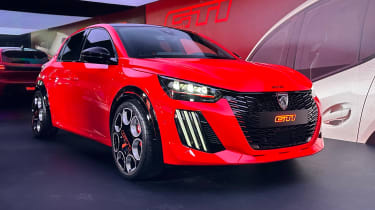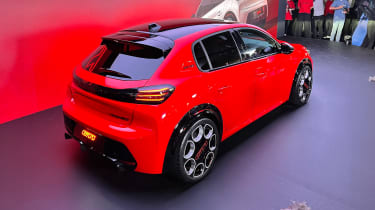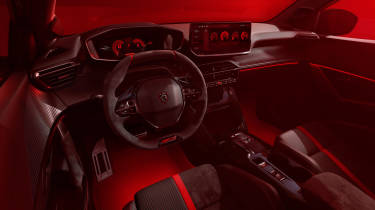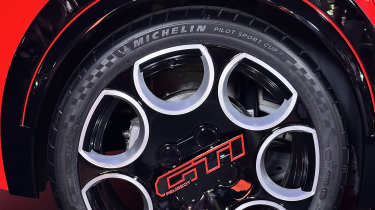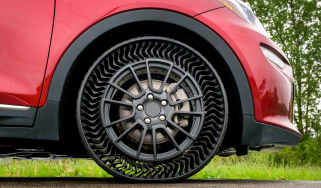New Peugeot 208 GTi – all you need to know about the Alpine A290 rival
Peugeot’s new electric hot hatch could be one of 2026’s best affordable performance cars. Here are all the juicy details
Seven years since the Peugeot 208 GTi was axed, it’s back, albeit in a different form to before. Launched at the 2025 Le Mans 24 Hours as the firm’s 9X8 Hypercar prepared to embark on the toughest endurance race on the calendar, the new model takes on the Alpine A290 and Mini Cooper JCW Electric as an all-electric hot hatch, sharing underpinnings with the Abarth 600e and Alfa Romeo Junior Veloce, albeit with some intriguing detail changes.
> Alfa Romeo Junior Veloce 2025 review – an electric crossover with hot hatch credentials
While the ordinary 208 is offered in a blend of combustion, hybrid and electric forms, the 208 GTi is available with electric power only, for now. Based on the same Stellantis-derived eCMP platform as its Italian relatives, it shares the same front-mounted motor and battery pairing, but based on our own experience with these cars, this is no bad thing.
2026 Peugeot 208 GTi – technical details
Mounted to the front axle is a new ‘M4+’ electric motor, built in France and developed with endurance racing expertise in mind. Producing 276bhp and 254lb ft of torque, output numbers are identical to its range-topping Alfa and Abarth relatives, sent through a mechanical limited-slip differential unlike the less powerful 217bhp Alpine A290 GTS.
Oddly, the new 208 GTi hits 62mph from a standstill in 5.7sec, two tenths sooner than the identically powerful Abarth 600e Scorpionissima and Alfa Romeo Junior Veloce. This could be due to it having the equivalent of a shorter final drive, which would also explain the marginally lower 112mph top speed, compared to the 124mph of its siblings. For reference, the combustion-powered 208 GTi managed a 6.5sec 0-62mph time at its best, with output standing at 205bhp in its top spec.
While Peugeot’s Le Mans Hypercar might be designed for endurance, the 208 GTi won’t go quite as far in one stint. Peugeot claims it can extract 217 miles from its ‘performance optimised’ 54kWh battery pack. Peugeot claims that learnings from the World Endurance Championship contender have been incorporated in the battery cooling, which as well as hopefully improving repeatability of performance, could explain the 10 mile bump on the claimed WLTP figure of its equally powerful Abarth 600e relative. Still, the smaller 52kWh battery of the Alpine A290 GTS is said to achieve 236 miles on a charge, perhaps thanks to a slightly lower weight figure. As with its eCMP siblings, 100kw fast charging and vehicle-to-load functionality are standard.
Specs might seem familiar, then, but Peugeot has done a lot to give the 208 GTi its own character. To help it stand out on the road and perform in more than just a straight line, ride height has been lowered by 30mm, track width increased by 56mm and 27mm front and rear, and even the arch trims subtly flared to accommodate the wider track. The diffuser and splitter are more aggressive too, with the former now featuring an integrated fog light.
Peugeot Sport says it has worked to ensure a true GTi feel in everything from the steering to the brakes, specifically tuning the springs and dampers (complete with hydraulic bumpstops, like the Abarth), the rear anti-roll bar and steering for optimum response. The ARB balance is now 50:50 front to rear, compared to 30:70 in the standard e208. There’s even a new Sport ESC mode to take assistance systems out of the equation, leaving everything to the driver for the very best roads. Brakes are chunky 355mm, four-piston items on the front axle (handy given the c1600kg weight figure).
The brakes should also have good feel when in Sport mode (the most driver-focused of the three modes, the others being Eco and Normal). That’s because in Sport the regenerative braking system is switched off, with the car only using its friction brakes for more consistent pedal feel. Regenerative braking comes back in Normal and Eco, and while there will be a loss of range with it disabled in Sport, this is deemed a worthwhile trade for the improvement in pedal feel.
We also expect the tyre choice to result in a bit of a range hit. Whether or not this will be a standard-fit option in the UK is yet to be seen, but Peugeot has launched the 208 GTi with 215-section Michelin Pilot Sport Cup 2 tyres, an ultra high-end option usually reserved for thoroughbred supercars – the Alfa Romeo Junior Veloce comes with much less extreme Michelin Pilot Sport EV tyres. In ideal conditions these tyres will give the Peugeot a significant leg up in terms of pace and feedback, but efficiency and wet weather performance are bound to take a hit.
Senior Vice President of Stellantis Motorsport, Jean Marc Finot, said: ‘Having been involved in the creation of the original 205 GTi 40 years ago, this new era of innovation with the E-208 GTi is especially meaningful to me and I am happy to find again the typical PEUGEOT GTi agility and steering feeling. I am proud to present a car that combines racing excellence with modern driving pleasure.’
2026 Peugeot 208 GTi – design and interior and prices
If you’ve spent much time around a standard Peugeot 208, the GTi’s design will be familiar. The design changes are far from radical, but a new red theme has been applied throughout to go along with the bold new GTi-exclusive red paint scheme. On the exterior, red highlights can be found in the headlights, badging, new darkened grille, rear spoiler and even the arch surrounds. It also continues on the controversial new 18-inch wheels, designed to reference the iconic design of the 205 GTi’s Speedlines – that new central GTi badge certainly won’t be for some…
Inside the theme continues, with red carpeting, floor mats and seat belts giving the cabin a bold new aesthetic. Switchgear and that compact, two-spoke steering wheel are shared with the ordinary car, but a good dose of Alcantara and fabric upholstery for the new, heavily bolstered sports seats give it a fresh new look. The digital dash and ambient lighting are set to a red theme out of the box, with faux carbonfibre trim also featuring on the dashboard.
Pricing for the new Peugeot 208 GTi is yet to be announced, but expect it to cost significantly more than its c£20k predecessor. The Abarth 600e Scorpionissima and Alfa Romeo Junior Veloce cost from £39,885 and £42,295 respectively, so a starting price of around £40,000 is inevitable.
2026 Peugeot 208 GTi specs and rivals
| 2026 Peugeot 208 GTi | Alpine A290 GTS | Mini Cooper JCW Electric | |
|---|---|---|---|
| Powertrain | Single-motor, front-wheel drive | Single-motor, front-wheel drive | Single-motor, front-wheel drive |
| Power | 276bhp | 217bhp | 254bhp |
| Torque | 254lb ft | 221lb ft | 251lb ft |
| Weight | c1600kg | 1479kg | 1650kg |
| Power-to-weight | c177bhp/ton | 149bhp/ton | 156bhp/ton |
| 0-62mph | 5.7sec | 6.4sec | 5.9sec |
| Top speed | 112mph | 106mph | 124mph |
| Range (WLTP combined) | 217 miles | 226 miles | 251 miles |
| Price | c£40,000 | £37,750 | £35,455 |
